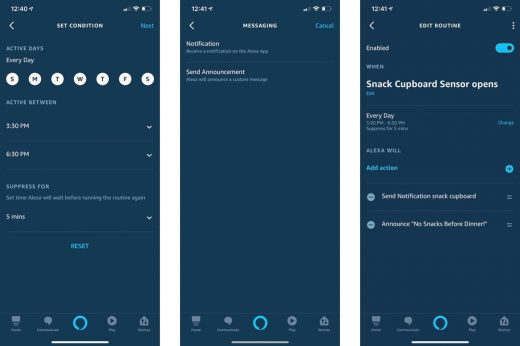The best smart home sensors for Alexa
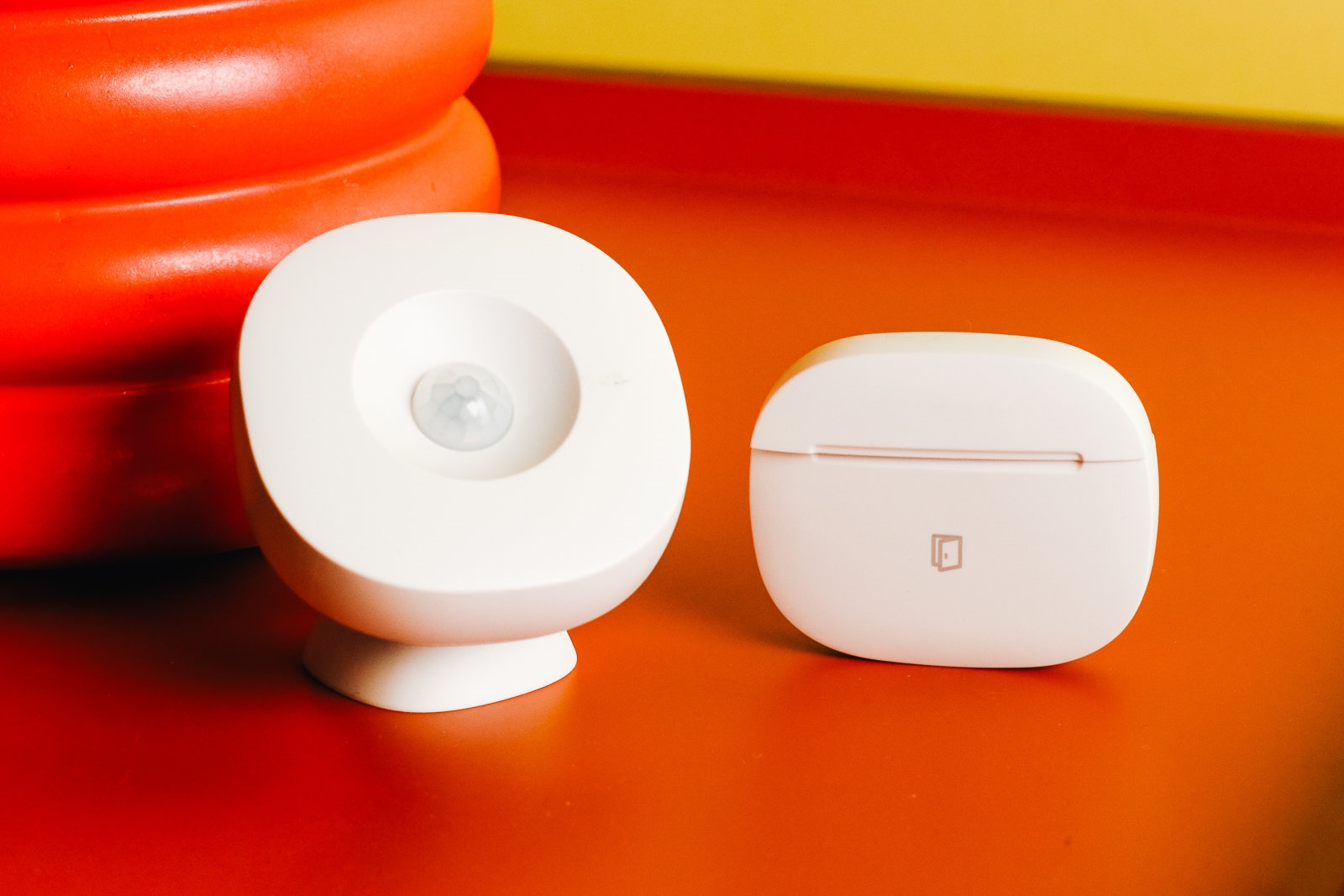
By Jennifer Pattison Tuohy
This post was done in partnership with Wirecutter. When readers choose to buy Wirecutter’s independently chosen editorial picks, Wirecutter and Engadget may earn affiliate commission. Read the full guide to smart home sensors for Alexa.
Among Alexa’s many tricks is that it also works as a smart-home hub. And adding smart sensors to an Echo Show or Echo Plus can turn either device into more than just an opponent for 20 Questions. Different sensors detect activity such as motion, a door or window opening, and temperature, and then tell other devices how to react. We recommend the Samsung SmartThings Motion Sensor and Samsung SmartThings Multipurpose Sensor for their reliability and wide compatibility with other devices.
The Samsung SmartThings Motion Sensor stands out among the few Alexa-compatible sensors because its long range lets it easily cover a large room (or even two), it can trigger in reaction to temperature as well as motion, and it’s super easy to pair with an Echo Plus or Echo Show (no SmartThings hub needed), so you can run Alexa Routines based on motion or temperature changes in the room. It’s a breeze to install, and thanks to a magnetic mount that’s easy to adjust, it fits almost anywhere you need it. The sensor is also water resistant (although it’s recommended only for indoor use).
At a typical price of just $20, the tiny Samsung SmartThings Multipurpose Sensor (Zigbee) does a lot for very little. Its main purpose is to serve as a contact sensor, and you can easily stick one of these on any door, window, or drawer to detect when they open or close. But it also has temperature and vibration sensors inside, so it can alert you—or act as a trigger for other smart devices—if a room or area is too hot or too cold. That makes it the most versatile sensor we tested: You can just as easily keep tabs on the doors and windows of a rental property as on a precious liquor cabinet.
Why you should trust us
As a journalist and editor with two decades of experience, I write about the smart home and connected living for Dwell Magazine, U.S. News World & Report, and The Ambient, among others. I’ve spent many, many hours testing connected devices for Wirecutter since 2016, including smart thermostats, smart garage-door controllers, smart sprinkler controllers, and smart smoke alarms.
In researching this guide I spent over six months living with a battery of Alexa-compatible sensors installed in my home, consulted multiple reviews of each device I tested, and scoured owner reviews and online forums to understand how people are using this technology in their homes.
Who are smart sensors for?
Smart sensors provide a hands-free, voice-free way to control other smart devices—lights, plugs, speakers, thermostats, and so on—based on environmental triggers such as a change in temperature, movement, or the opening or closing of a door. So if you like the idea of having automation throughout your home, and not just the ability to control smart devices using a smartphone or your voice, you should consider installing one (or several).
For instance, a motion sensor installed at the top of a stairway can automatically turn on lights downstairs, adjust the thermostat, and start playing music. A contact sensor on an exterior door can send an alert when your Airbnb tenant arrives. And a temperature sensor in a child’s room can alert you if it’s too hot, cold, humid, or dry, and adjust a fan or thermostat if you like. You can adapt all of these actions to the time of day as well as the day of the week, so you don’t have to deal with unwanted device triggers—such as blaring music in the middle of the night if you merely pop downstairs for a glass of water.
Alexa lets you link sensors to your other Alexa-compatible devices with automated rules that Amazon calls Alexa Routines. These are if-this-then-that commands (for example, if the motion sensor detects motion, then the living room lamp turns on) tied to one or more devices activated by changes in conditions in your home (rather than by voice or mobile-app commands or by preset timers). So instead of having to ask Alexa to turn on the lights when you enter a certain room, you know that they’ll just turn on automatically when you walk in.
Alexa also brings some useful features not available with other smart-home hubs, most notably involving audio. For example, if you have an erratic wake-up schedule, you can put a motion sensor by your bed to turn on the lights, adjust the thermostat, get your Flash Briefing and calendar for the day, start the kettle boiling, and then finish up with your “Good Morning” Spotify playlist no matter when you get up (I use this particular routine in my own home). At night, you could have Alexa turn on a night-light and start telling a bedtime story when your child enters their room.
Sensors are also useful for quickly learning information about the ambient conditions in your home. You can ask Alexa if the front door is open, for example, or what the temperature is in the baby’s room, and get an instant response through your smart speaker without having to dig through the apps on your phone.
How to use sensors with Alexa
The easiest way to use sensors with Alexa is by pairing them with an Amazon Echo Plus or Amazon Echo Show (2nd Gen). Both models have a wireless Zigbee radio that’s compatible with many other smart-home devices (you can be sure a device is compatible if it has a Works with Alexa badge on its package) and turns either speaker into a more powerful hub than the standard Echo. There’s no need to enable Alexa skills or to set up any separate apps as you might with other devices: Simply say “Alexa, discover devices,” and they’ll appear in the companion Alexa app.
Things get a little more confusing if you want to use sensors with a non-Zigbee Echo device such as an Echo, Dot, Spot, or Show 5. For those, you also need an Alexa-compatible smart-home hub like Samsung’s SmartThings or Wink, or a security system hub like those of Abode, Ring, or Scout (for a deeper explanation, see Using sensors with Alexa and a smart hub). You can find a few Wi-Fi–based sensors that can pair with a non-Zigbee Echo without requiring the use of a hub, but most of those can’t trigger Alexa Routines, and so can’t serve to automate your home.
Currently, only three manufacturers offer Works with Alexa–certified sensors: Samsung SmartThings, Sylvania Lightify, and Philips Hue. Although a sensor may advertise compatibility with Alexa, if it’s not certified under Works with Alexa, you can’t be sure that it has the ability to trigger Alexa Routines. (As a general rule of thumb, if you need to install an Alexa skill to enable a sensor or device, then it typically isn’t a sure thing.)
Once Alexa has discovered your sensor, you can select it when creating a routine. Open the Alexa app and choose Routines, tap the plus sign, and start a new routine: Choose When this happens, and then on the next screen choose Device. Scroll through and find the sensor you just added. If the sensor has more than one built-in detector that Alexa recognizes (motion and temperature, for example), choose which one to use.
After you’ve added your sensor to a routine, you can tailor the routine to your needs. Choose when this routine will run (day, time, or anytime), set the duration (how long Alexa will wait before running the routine again), and add the actions you want to happen—for example, play music, activate other smart-home devices (or groups or a scene), or have Alexa say something (such as “Front door is open”).
We found that using sensors with Alexa was a pretty good experience, elevating the voice assistant from a convenience to a key part of our smart home. Pairing sensors is super simple—the easiest process among all the smart-home hubs we’ve tested—and Alexa Routines are straightforward to set up.
Alexa’s smart-hub shortcomings
Alexa’s software isn’t always as reliable as other smart-home platforms, and the app is the weakest part of the Alexa-and-sensor experience. In our testing, a few of our routines stopped working randomly; sometimes we could get them back by deleting them and setting them up again, while other times we had to completely unpair and re-pair the sensor.
We also disliked having to scroll through our entire list of smart devices in order to add a sensor to a routine—dividing them up by rooms or function instead would be a big improvement. And we found that some of the settings were especially fiddly: The slider bars for adjusting brightness or temperature were glitchy and hard for us to move precisely, and accessing the Play/Delete Routine button is frustratingly difficult if you have a case on your phone, as it’s tucked right in the very top corner.
Additionally, the app offers no direct access to a sensor’s controls, so you can’t adjust motion sensitivity, nor can you find logs of the temperature over a time period or of activities, such as when a door is accessed. These features are standard in competing smart-home ecosystems such as SmartThings and HomeKit.
Another area where Alexa is lacking is in temperature sensing. For more simple situations, such as turning a fan on when it gets too hot, or a heater when it gets too cold, the Echo Plus and Echo Show (2nd Gen) have built-in temperature sensors that can trigger routines, and both of our picks for motion and contact sensors detect temperature, too. However, Alexa doesn’t support humidity readings, a key factor in monitoring temperature in a sensitive space such as a baby’s room or a wine cellar. Amazon has indicated that support will be coming at some point.
For most people, we think Alexa’s easy integration with sensors makes it a good way to start incorporating these powerful devices into your home and actually making your home smarter, but if you’re already a smart-home super-user, you’ll be better off with a more customizable platform like SmartThings or HomeKit.
How we picked and tested
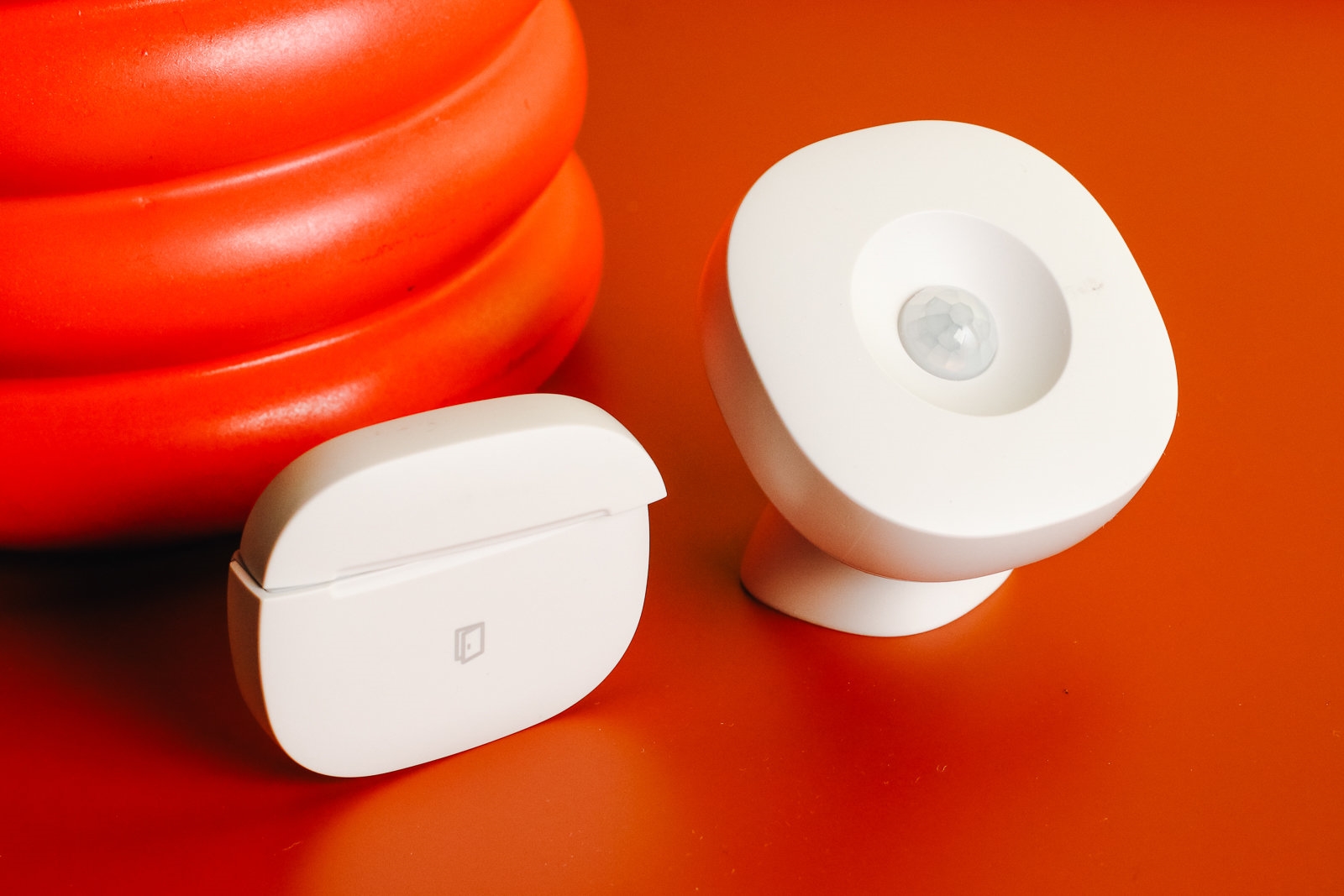
Very few natively compatible sensors are available for Alexa, so we tested them all. Our focus was on sensors that are convenience-oriented—specifically motion sensors and contact sensors (which detect when a door or window opens or closes)—rather than ones that are oriented around safety. Alexa Routines can now also trigger based on temperature, but at this writing there are no standalone temperature sensors. However, temperature sensing is possible with both our contact sensor and motion sensor picks. (If you’re interested primarily in sensors for a DIY home security system, see our guide to the best home security system; we cover other environmental sensors in our guides to the best smart smoke detector and the best water leak detector.)
A motion sensor mounts to a wall or ceiling, or sits on a flat surface, and triggers other smart devices (such as lights) or smart-home routines based on your movements. For example, you might set up a routine where if motion is detected in a hallway between 6 p.m. and 9 p.m., the hallway lights will turn on, the thermostat will adjust, and music will play.
Contact sensors have two parts, a sensor and a magnet, which attach to either side of a door, window, cabinet, drawer, or anything else that opens and closes. When the contact between the sensor and magnet breaks or reestablishes, a trigger occurs. That action can be as simple as sending a smartphone alert to let you know that a door opened, or the trigger can start a smart-home routine. Most commonly used on doors and windows as part of a security system, contact sensors can go anywhere something opens or closes: blinds, gates, fridges, drawers, medicine or liquor cabinets, pet doors, garage doors, and so on.
Although some Wi-Fi and Bluetooth sensors work with Alexa to send you alerts and let you ask about their status through voice, for this guide we focused only on those that can trigger Alexa Routines, which limited us to Zigbee-compatible devices.
To test the sensors we installed them in a four-bedroom, 2,500-square-foot home with three exterior doors. We set up similar Alexa Routines and actions for each device and went about daily life with a family of four people and two pets. During that time we monitored the reliability of the sensors at triggering routines, the response times, the range and field of view, and whether pets triggered the motion sensors.
We evaluated the design, build quality, size, and mounting options. We considered pet immunity—the ability of a sensor to ignore the motion of animals—but we found that none of these features were effective unless we specifically positioned the sensor to point well above the ground. A crucial factor for sensors is the battery life, the source of the biggest number of complaints in owner reviews, and we will monitor that as part of our long-term testing.
Best Alexa motion sensor: Samsung SmartThings Motion Sensor
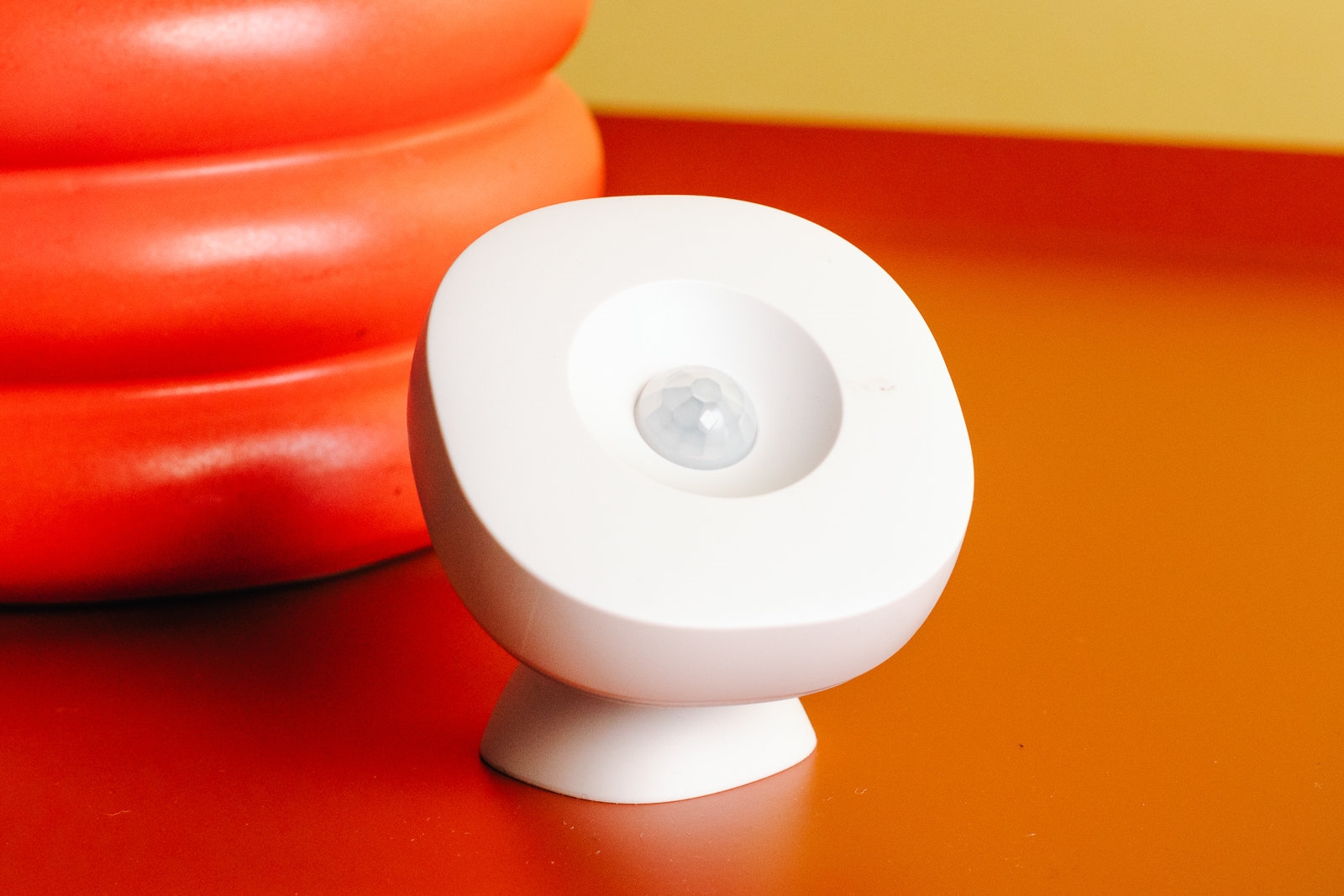
In our testing we found that Samsung’s SmartThings Motion Sensor was the best motion sensor for use with Alexa. We especially like its wide field of view and long range, the best of any of the models we tested (120 degrees and 15 feet, respectively), which allowed it to cover a whole room and then some—plus, it also detects temperature. Its compact size and attractive design make it easy to install discreetly. Its magnetic mount is also easy to set up and is adjustable once in place, which helps for optimizing range and view (other sensors need to be completely removed first). We also like that it can work natively with Alexa through the Echo Plus or Echo Show 2, or paired through a SmartThings hub to any Echo speaker (if you have a Plus, however, we recommend pairing it through that, so you can skip the SmartThings hub altogether).
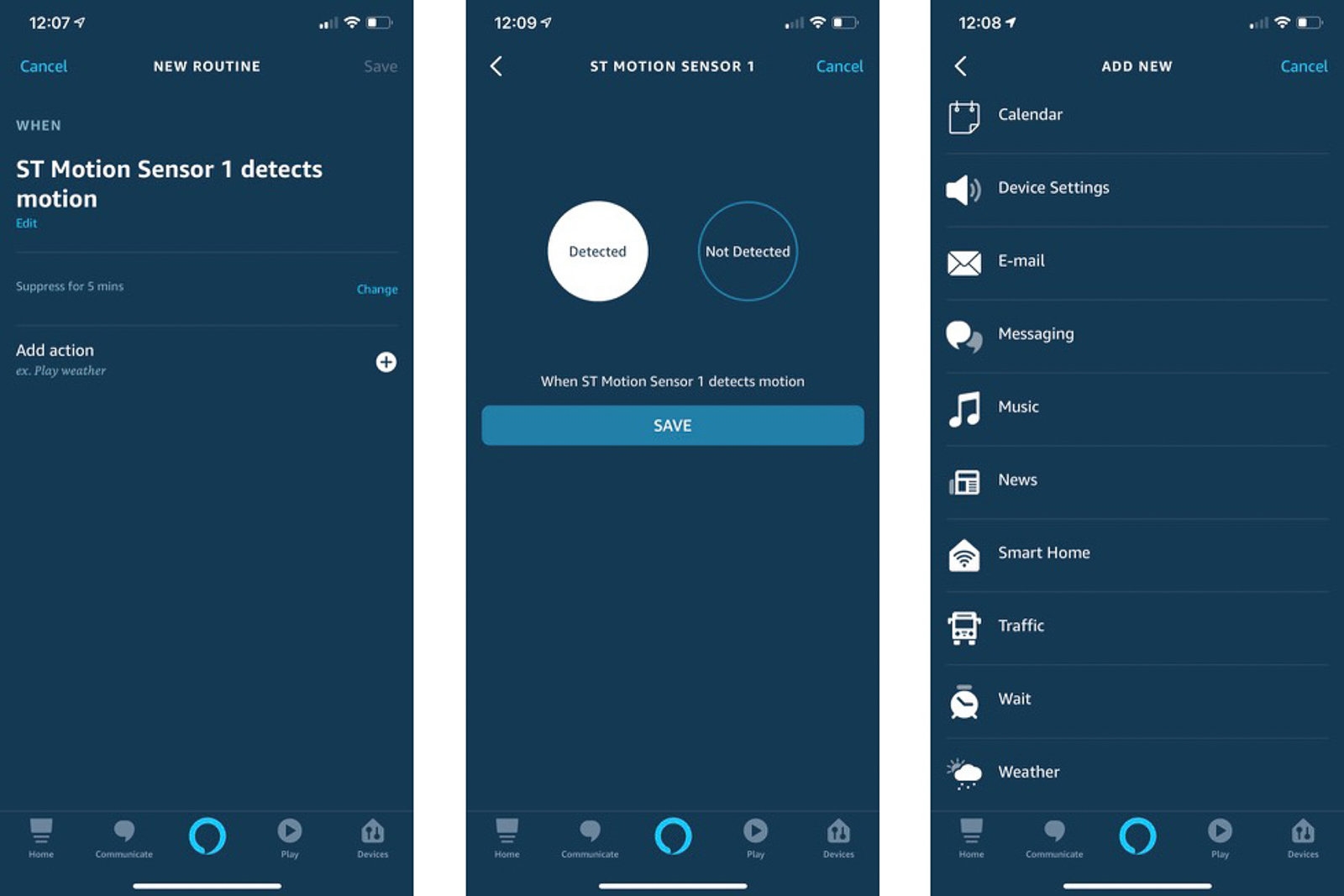
The SmartThings sensor reacted quickly in our light routine test. We created a routine that turned on a smart light bulb in a laundry room when it detected motion, and then set it to stay for just five minutes using a Wait command. We then tested a second scenario where we set up one routine to turn the kitchen lights on when motion was detected and another to turn them off when motion was no longer detected.
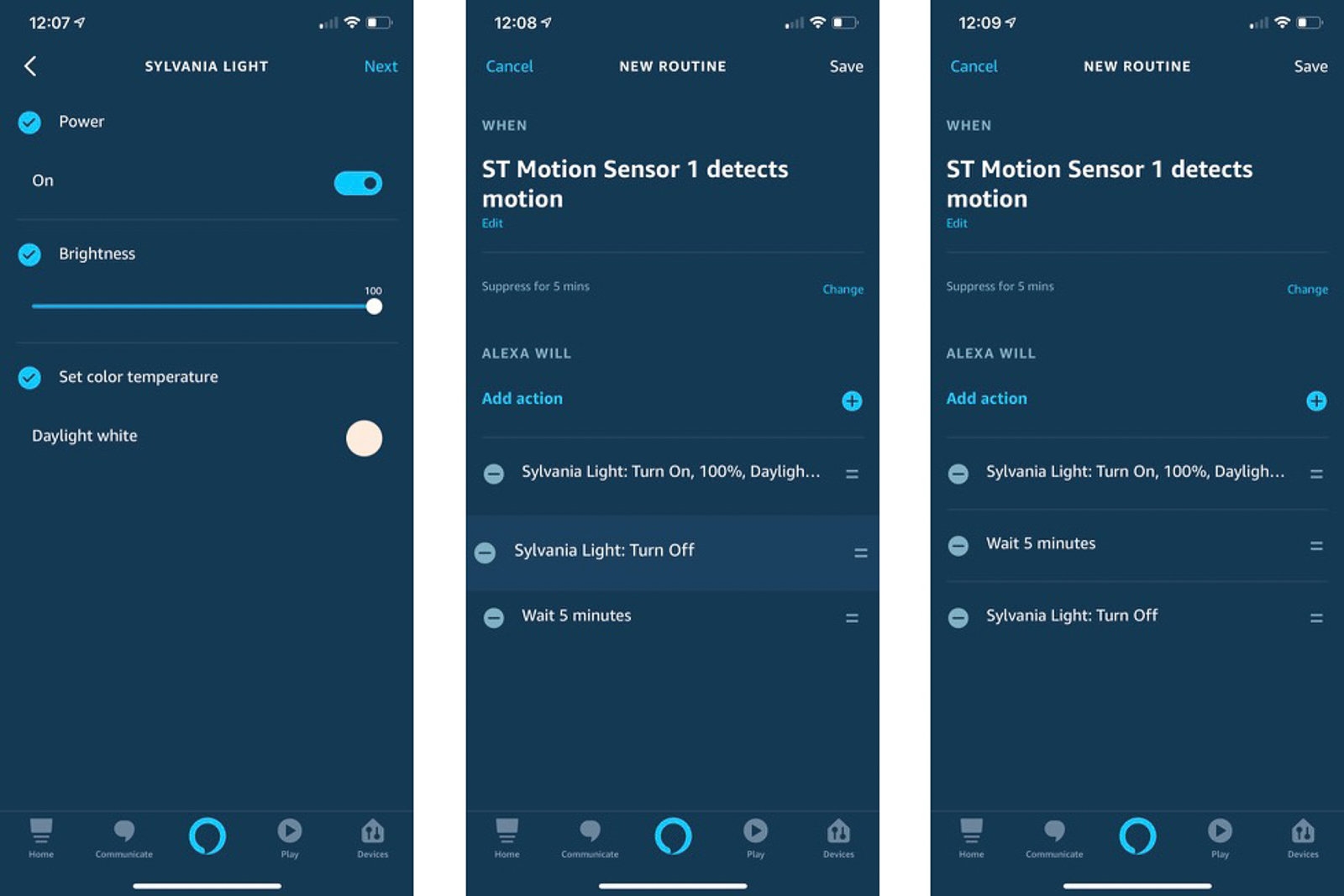
The sensor is easy to put in a room due to its small size, good-looking design, and adjustable magnetic mount. (We did find that the sensor was easy to knock off its mount when bumped; if it’s located in an active area, you may want to place it on a shelf or other flat surface.)
Another model we like is the Philips Hue Motion Sensor (Zigbee), which can now pair directly to an Echo Plus or Echo Show (2nd Gen) without needing a Philips Hue Smart Hub. It’s more expensive than our pick, slightly bulkier, and restricted to a narrower field of view (100 degrees versus 120); it also isn’t water resistant. But we like that it has a similar magnetic mount that makes installation and adjustment easy; plus, you can install the mount with screws, an advantage over the SmartThings device. It also detects temperature, but Alexa isn’t able to recognize its built-in ambient-light sensor, so if you want to use it to control Hue lighting, you can pair it with its own hub for more features (and it will still show up as a sensor in Alexa).
Best Alexa contact sensor: Samsung SmartThings Multipurpose Sensor
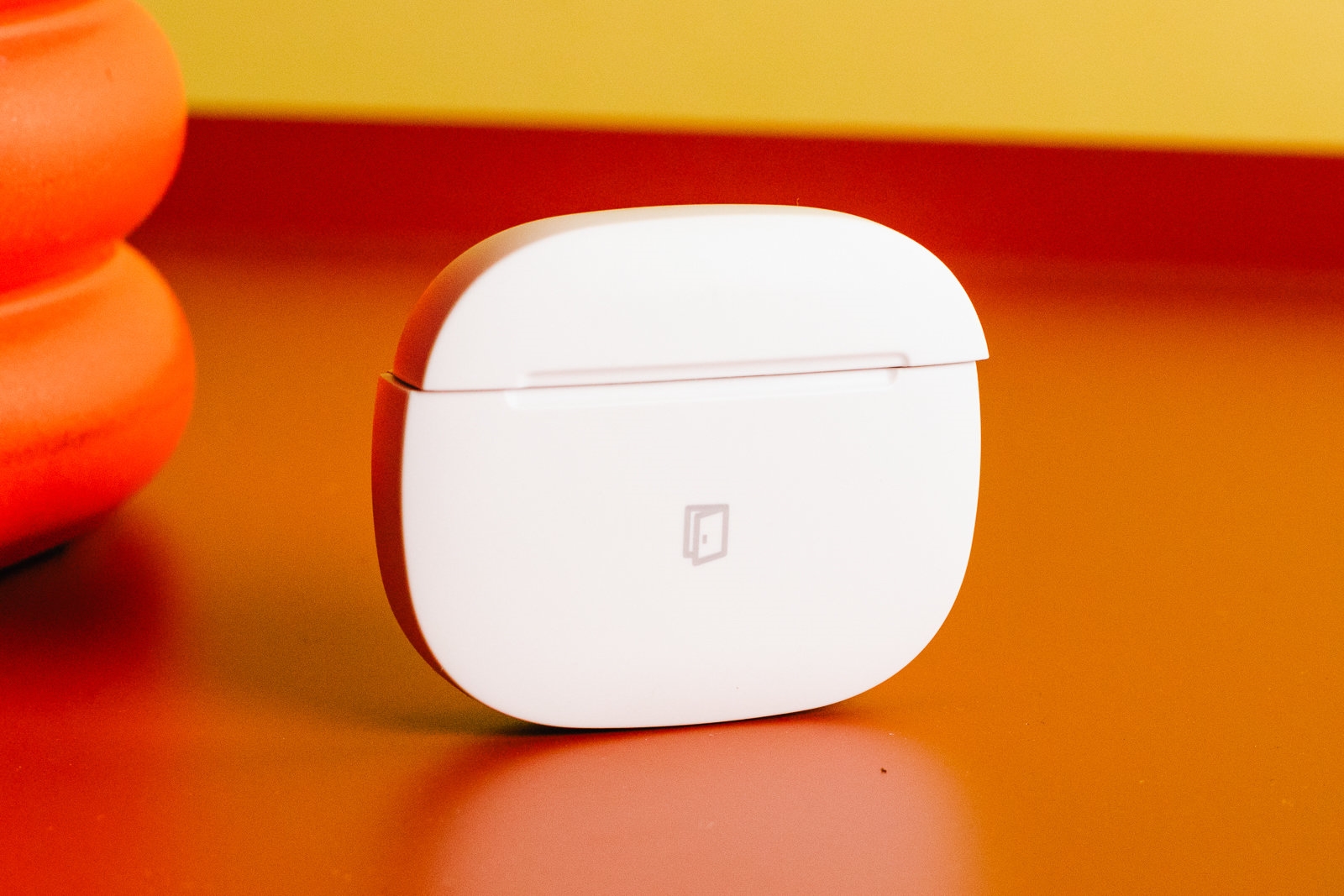
The Samsung SmartThings Multipurpose Sensor is our recommended contact sensor because of its excellent response time and a small, unobtrusive design that fits easily nearly anywhere. Most other contact sensors we tested were large and bulky, making it difficult to fit them in more unusual spots (inside drawers or on blinds). The SmartThings model is also inexpensive, which is important for a device you might want to place in multiple parts of your home. And this was the only contact sensor we tested that can use temperature as a trigger.
We like that the Multipurpose Sensor works natively with Alexa through the Echo Plus or Echo Show (2nd Gen) but can also pair through a SmartThings hub to any Echo speaker (again, if you have a Plus, there’s no need to add the SmartThings hub).
The Multipurpose Sensor is simple to install, as the device is prefitted with strong tape and the rounded shape makes it clear where the magnet needs to go. The sensor itself is also magnetic, giving you another option for mounting. To test it, we installed it on a pantry door and created three routines: one that turned on the pantry light when the door opened, one that turned it off when the door closed, and a third that sent an announcement from the kitchen’s Echo Show saying “No snacks before dinner!” and turned the Hue lightbulb in the home office red if the door opened between 3:30 p.m. and 6:30 p.m.
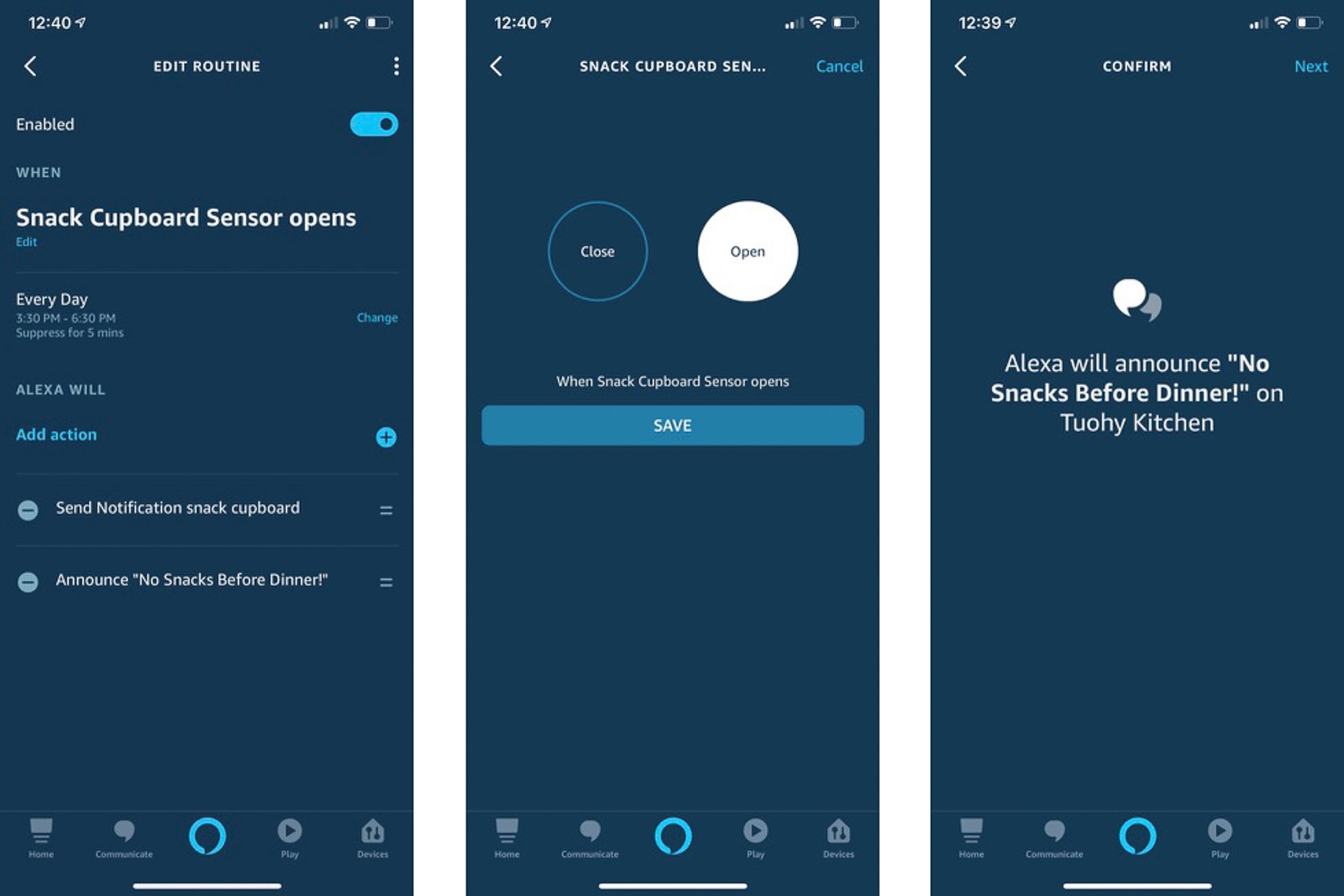
All the contact sensors we tested were able to trigger these routines, but we made the SmartThings sensor our pick for its speed of response and its combination of simplicity, compatibility, design, and price.
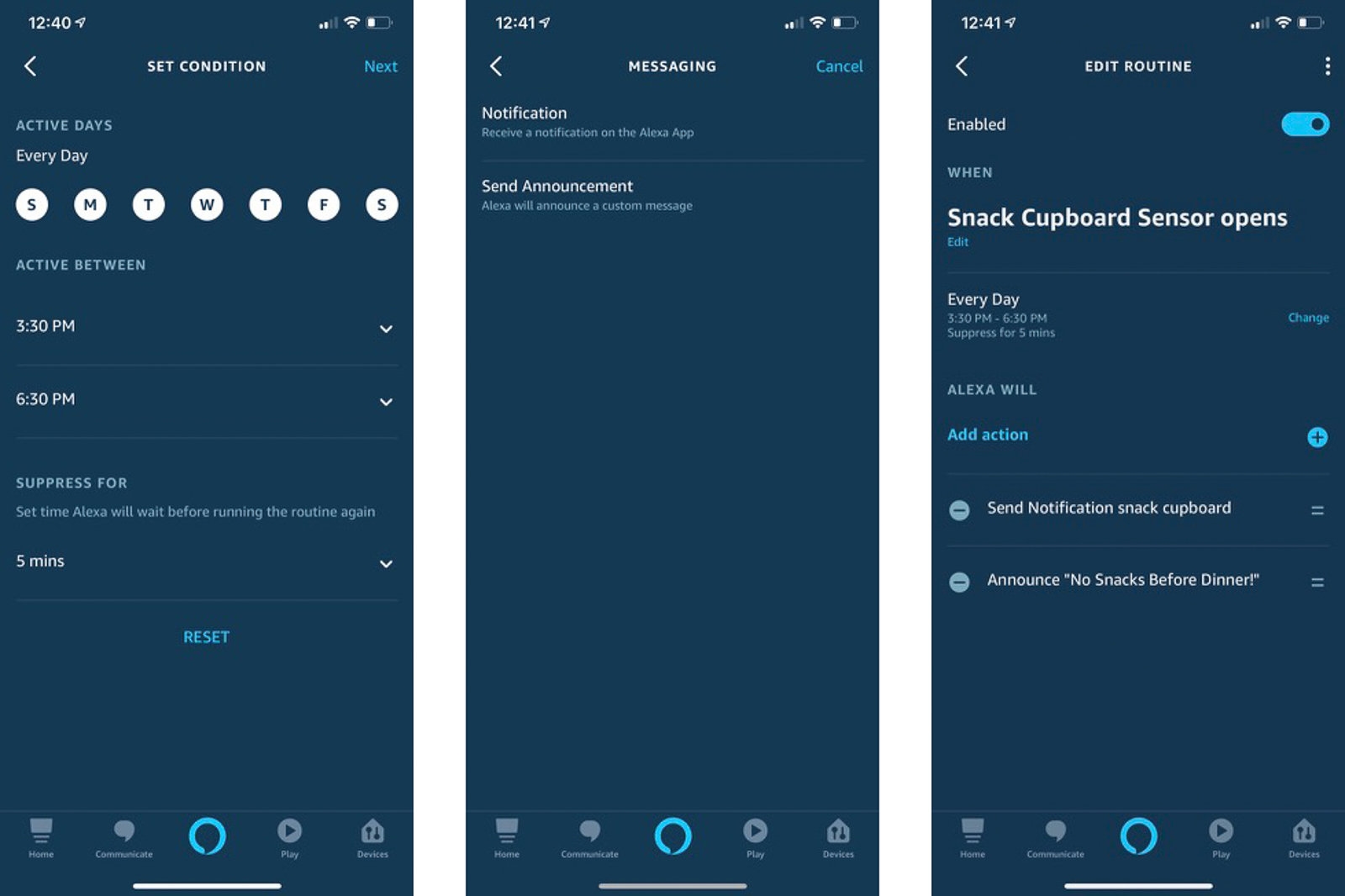
What to look forward to
Philips Hue’s new Outdoor Sensor (Zigbee) can now pair directly to an Echo Plus or Echo Show (2nd Gen) without needing a Philips Hue Smart Hub. This motion sensor can trigger any lights, indoors or out, as well as any other routines it’s associated with. Unlike the devices we tested, it is designed for outdoor use and is therefore fully waterproof. We’ll test it and update this guide accordingly.
The competition
The Sylvania Lightify Motion and Temperature Sensor has an oddly shaped housing, and its sensor portion noticeably projects from the device, giving it a somewhat rude appearance. Although the shape does make it easy to install in a corner, bizarrely it has no predrilled screw holes in the mount, which we think is problematic. It has just a 100-degree field of view (less than our pick) and a 14.5-foot range (similar to our pick). You can use both temperature and motion to trigger routines.
The Monoprice Stitch Door and Window Sensor is currently the only sensor that connects to Alexa through Wi-Fi, so it can connect directly with any Echo, not just the Echo Show or Echo Plus, and it doesn’t need a separate smart-home hub or security hub to trigger routines (though it’s not Works with Alexa certified). It’s inexpensive and attractive, but it’s comparatively bulky, owing to the two AAA batteries it requires to keep running on power-sucking Wi-Fi. Additionally, in our testing it took between two and eight-plus seconds to trigger a routine—much longer than sensors that connect via Zigbee. Monoprice also sells a motion sensor, but that model is unable to trigger routines (only the Stitch contact sensor can), so you still need a hub if you want to use motion sensors in your home. Also, Monoprice’s native app has a truly heinous-sounding alert, which you cannot change (although you can turn it off, which we did immediately).
Using sensors with Alexa and a smart hub
If you own a smart-home hub such as a SmartThings or Wink, or a smart home security system from Abode, Honeywell, Ring, or Scout, smart sensors connected to that hub can trigger Alexa Routines via any Alexa smart speaker (that is, not just the versions with a Zigbee hub). Companies with compatible sensors include Aeotec, Ecolink, Fibaro, GE/Jasco, GoControl, and Sensative. (Check out Wirecutter’s guide to the best smart-home sensors for SmartThings for our favorite smart-home hub’s compatible sensors.)
To do this, set up the hub according to its manufacturer’s directions, link the sensors to it, and then enable that system’s skill in your Alexa app. For use with an Echo device, we recommend the SmartThings hub, and either Ring or Abode’s smart home security system if you are looking for a monitored security system as well.
For this guide we tested the contact and motion sensors that come with Ring and Abode’s respective basic security packages to see how the integrations worked. We did not include them in our list of picks, though, as you would need to pay a minimum of $200 to buy the basic system first. However, if you are considering a security system or have one in place and want to expand the use of sensors in your smart home, these are good options.
In testing, we found a slightly longer delay in routines triggered by sensors connected to a second smart hub compared with those connected directly to an Echo hub. We also found—because they’re designed as security sensors—that both the Ring and Abode motion sensors are comparatively large and less easy to install discreetly. The same is true of Ring’s contact sensors. (We also don’t love the Ring logo displayed so prominently on all its sensors.) But we do like that they have optional hardware mounts, which are more secure than tape and notably absent from most of the devices we tested. Abode’s contact sensors were much more slimline and unobtrusive.
Crucially, for some uses, contact sensors from security companies often have the ability to trigger a chime when the door opens and closes; both the Ring and Abode sensors have this capability, but none of the Alexa-compatible sensors we tested do. (One workaround is to set up a routine in which Alexa announces a trigger instead, such as “The front door has opened.”)
This guide may have been updated by Wirecutter. To see the current recommendation, please go here.
When readers choose to buy Wirecutter’s independently chosen editorial picks, Wirecutter and Engadget may earn affiliate commissions.
(67)

